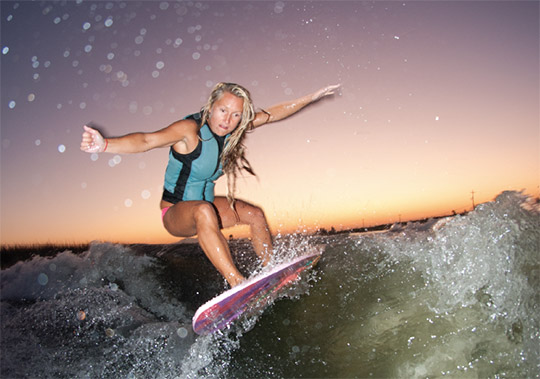 Anyone who believes that American men have the competitiveness market cornered has not yet met Bri Chmel. She’s just past 30, just over five feet tall, and just about as hard a charger as you’re likely to meet, male or female. And over the course of the past six years she’s come to dominate the sport of women’s wakesurfing.
Anyone who believes that American men have the competitiveness market cornered has not yet met Bri Chmel. She’s just past 30, just over five feet tall, and just about as hard a charger as you’re likely to meet, male or female. And over the course of the past six years she’s come to dominate the sport of women’s wakesurfing.
By the age of 14, Chmel (pronounced ka-MEL) was already a top-ranked professional snowboarder, standing fifth nationwide, giving up the sport only when sidelined by an injury. Since 2007, Chmel has earned 18 first-place finishes in wakesurfing competitions; she is a six-time Women’s World Wakesurfing Champion and is president and founder of the Women’s Wakesurf Association; a Certified Level 1 Crossfit coach and Crossfit gym record holder and was on a Washington State Olympic Development soccer team. Her sponsorships include Centurion Boats, Victoria Skimboards, Kandy Wrappers Swimwear and Von Zipper Eyewear. In her 30 years, she has visited as many countries, including Botswana, Denmark, Indonesia, Australia, Zimbabwe, the Dominican Republic and South Korea. She continues to travel the world, doing product photoshoots, conducting clinics and promoting her sport.
Wakesurfing may not be familiar to those more accustomed to riding natural Pacific Ocean waves. But in inland lakes and rivers throughout America, the sport has taken flight. Pioneering ocean surfers tried surfing behind ski boats in the 1950s and 1960s but it wasn’t until wakeboarding became popular a couple of decades later that it really took off. The difference between wakeboarding and wakesurfing? In ’boarding, the rider’s feet are strapped on and he or she holds a rope attached to the boat, much like water skiing. The sport developed from a combination of water skiing and snowboarding, with moves and techniques derived from each.
Wakesurfing, on the other hand, does away with the straps and the rope, leaving the surfer to simply ride the wave generated by the boat. Hulls are specially designed to displace as much water as possible, creating a large wave. Waves created this way last much, much longer than their ocean counterparts— indeed, they’re only limited by how much fuel the boat can carry. Another variant, wakeskating, also does away with any attachment between the board and boat, but the boards are smaller. This activity is more closely aligned with skateboarding.
Bri Chmel was smitten by wakesurfing the first time she saw a competition. “I started my sponsorship with Centurion Boats in 2006, when I was competing in wakeskating,” she says. She was living in Orlando, Florida, at the time, and traveled to Clear Lake (in Lake County, Northern California) for Centurion’s annual photoshoot. “That’s where I first saw wakesurfing, at the World Wakesurfing Championships.” She’d never attempted the sport before, but that competitive spirit kicked in. “Just watching, I knew I could beat all of them the next year.”
And she did. In fact, she’s still winning. “Bri is one of the most driven professional athletes I’ve ever met,” says Todd Gaughan, vice president of marketing for Centurion Boats. “She is also the owner of the biggest comeback in the history of her spor t.” This was during 2013 World Wakesurfing Championship at Lake Las Vegas.